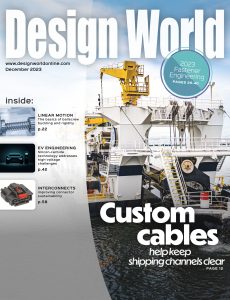
Design World – December 2023
English | 68 pages | pdf | 113.85 MB
JCB recently announced that it will build a new factory in North America, creating 1,500 new jobs over the next five years. The British company is a global manufacturer of construction equipment and also builds machinery for the agricultural and waste-handling industries. JCB said this new facility will manufacture machines mostly for North American customers. This continues a
trend of local for local manufacturing that we’ve seen, as well as onshoring or reshoring manufacturing jobs to the U.S. Construction on the 720,000 sq-ft factory is slated to begin in the early months of 2024, on a 400-acre site in San Antonio. And if you’ve been paying attention to geopolitics over the last few years, this shouldn’t surprise you at all. Texas has seen an incredible boom, especially in San Antonio, Austin, and Houston. Sectors such as energy and tech are big drivers of the growth, and these high-paying jobs are changing how these cities look. Austin’s skyline today is hardly recognizable compared to 10 years ago, and the apartment towers continue to sprout up like weeds.
Peter Ziehan, who speaks regularly on geopolitics at industry events like the National Fluid Power Association’s and Power Transmission Distributors Association’s conferences, has been predicting continued growth here for some time. He notes that the state has had among the fastest growing demographics over the last three decades. Plus, the cost of living is relatively low there. But another key aspect is the state’s proximity to Mexico. Roughly half of U.S.-Mexico trade is actually Texas-Mexico trade — and of the remaining, half of that travels through Texas. (I highly recommend Ziehan’s free daily video newsletter; you can subscribe at zeihan.com.) According to Ziehan, a problem with U.S. manufacturing is that we don’t have different wage and skill levels here; in that respect, our country is fairly homogeneous from state to state.
In other regions of the world, say, Southeast Asia, various skill levels and wages exist across nearby countries that are mostly friendly toward each other. Think Singapore for high-skilled, Indonesia for medium-skilled, and Laos for low-skilled jobs. This makes setting up localized manufacturing ecosystems easier, as the proper jobs go to the proper areas. Efficiency!
But when you add Texas and northern Mexico together, there is some of the synergy needed for robust manufacturing facilities, where some jobs are more basic and others more skilled. It’s not a complete answer, and
northern Mexico seems poised to run out of manufacturing workers soon, given the explosion in facilities in Mexico that have cropped up in recent years.
Still, it will be an interesting area of the country to watch in the coming years. As my eldest son finishes up his engineering degree at college, I’m left to wonder if his career path will eventually take him to that ever-growing region.
Download from: